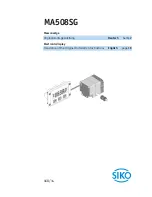
Specifications
12
Monitor
MultiSync
®
LCD
1525S
™
Notes
Specifications
Monitor
LCD Module
Diagonal:
15.4 inch
Active matrix; thin film transistor (TFT)
Viewable Image Size:
15.4 inch
liquid crystal display (LCD); 0.2385 mm dot
Native Resolution (Pixel Count):
1280 x 1024
pitch; 200cd/m
2
white luminence;
200:1 contrast ratio, typical
Input Signal
Video:
ANALOG 0.7 Vp-p/75 Ohms
Sync:
Separate sync. TTL Level
Horizontal sync. Positive/Negative
Vertical sync. Positive/Negative
Composite Sync. (Positive/Negative) (TTL Level)
Sync on Green video (Positive) 0.7 Vp-p and sync.
Negative 0.3 Vp-p
Display Colors
Analog input:
Unlimited number of colors
Depends on display card used.
Viewing Angle
Left/Right:
±
60
°
Up:
50
°
Down:
45
°
Synchronization
Horizontal:
24.0 kHz to 80.0 kHz
Automatically
Range
Vertical:
56.0 Hz to 76.0 Hz
Automatically
Resolutions Supported
720 x 400*: VGA text
Some systems may not support
Resolution based on horizontal and
640 x 480 at 60 Hz to 76 Hz
all modes listed.
vertical frequencies only
800 x 600* at 56 Hz to 76 Hz
832 x 624* at 75 Hz
1024 x 768* at 60 Hz to 76 Hz
1152 x 900* @ 60 Hz (SUN)
1280 x 960 at 60 Hz to 76 Hz
1280 x 1024 at 60 Hz to 76 Hz ................ NEC cites recommended resolution at
60 Hz for optimal display performance.
Active Display Area
Horizontal:
305 mm/12.0 inches
Dependent upon signal timing used,
Vertical:
244 mm/9.6 inches
and does not include border area.
USB Hub
I/F:
USB Specification Revision 1.1
Port:
Upstream 2
Downstream 4
Load Current:
Maximum 0.5A per port
Power Supply
AC 100 – 240 V @ 50/60 Hz
Current Rating
1.1 A @ 100 – 120 V/0.6 A @ 220 – 240 V
Dimensions
370 mm (W) x 360 mm (H) x 158 mm (D)
14.6 inches (W) x 14.2 inches (H) x 6.2 inches (D)
Weight
5.0 kg
11.0 lbs
Environmental Considerations
Operating Temperature:
5
°
C to 35
°
C/41
°
F to 95
°
F
Humidity:
30% to 80%
Feet:
3,000m/10,000 Feet
Storage Temperature:
-10
°
C to +60
°
C/14
°
F to 140
°
F
Humidity:
10% to 85%
Feet:
9,500m/31,500 Feet
*
Interpolated Resolutions: When resolutions are shown that are lower than the pixel count of the LCD module, text may
appear different. This is normal and necessary for all current flat panel technologies when displaying non-native
resolutions full screen. In flat panel technologies, each dot on the screen is actually one pixel, so to expand resolutions to
full screen, an interpolation of the resolution must be done.
NOTE: Technical specifications are subject to change without notice.
78134761.wpc
9/16/99, 4:10 PM
14















































